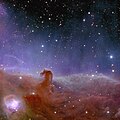Fayil:Euclid’s view of the Horsehead Nebula ESA25170866.jpg

Hoton asali (pikisal 8,200 × 8,200, girman fayil: 1.84 MB, irin MIME: image/jpeg)
Wannan hoto yazo daga Wikimedia Commons kuma za'a iya amfani dashi a wasu projects. Anan kasa an nuna asalin bayanin shi
Taƙaici
| BayaniEuclid’s view of the Horsehead Nebula ESA25170866.jpg |
English: Euclid shows us a spectacularly panoramic and detailed view of the Horsehead Nebula, also known as Barnard 33 and part of the constellation Orion.
At approximately 1375 light-years away, the Horsehead—visible as a dark cloud shaped like a horse’s head—is the closest giant star-forming region to Earth. It sits just to the south of star Alnitak, the easternmost of Orion’s famous three-star belt, and is part of the vast Orion molecular cloud. [Image description: This square astronomical image is divided horizontally by a waving line between a white-orange cloudscape forming a nebula along the bottom portion and a comparatively blue-purple-pink upper portion. From the nebula in the bottom half of the image, an orange cloud shaped like a horsehead sticks out. In the bottom left of the image, a white round glow is visible. The clouds from the bottom half of the image shine purple/blue light into the upper half. The top of the image shows the black expanse of space. Speckled across both portions is a starfield, showing stars of varying sizes and colours. Blue stars are younger and red stars are older.] Tiếng Việt: Tinh vân Đầu Ngựa, còn được gọi là Barnard 33 và là một phần của chòm sao Orion |
| Rana | 7 Nuwamba 2023 (upload date) |
| Masomi | Euclid’s view of the Horsehead Nebula |
| Marubucin | ESA/Euclid/Euclid Consortium/NASA image processing by J.-C. Cuillandre (CEA Paris-Saclay) G. Anselmi |
| Other versions |
|
| Activity InfoField | Space Science |
| Keyword InfoField | Horsehead Nebula Stars |
| Mission InfoField | Euclid |
| Set InfoField | Euclid First Images |
|

|
This image was selected as picture of the day on Vietnamese Wikipedia.
|
Lasisi
This media was created by the European Space Agency (ESA).
Where expressly so stated, images or videos are covered by the Creative Commons Attribution-ShareAlike 3.0 IGO (CC BY-SA 3.0 IGO) licence, ESA being an Intergovernmental Organisation (IGO), as defined by the CC BY-SA 3.0 IGO licence. The user is allowed under the terms and conditions of the CC BY-SA 3.0 IGO license to Reproduce, Distribute and Publicly Perform the ESA images and videos released under CC BY-SA 3.0 IGO licence and the Adaptations thereof, without further explicit permission being necessary, for as long as the user complies with the conditions and restrictions set forth in the CC BY-SA 3.0 IGO licence, these including that:
See the ESA Creative Commons copyright notice for complete information, and this article for additional details.
|
 | |
This file is licensed under the Creative Commons Attribution-ShareAlike 3.0 IGO license. Jinginarwa: ESA/Euclid/Euclid Consortium/NASA, image processing by J.-C. Cuillandre (CEA Paris-Saclay), G. Anselmi, CC BY-SA IGO 3.0
| ||
This file, which was originally posted to
Euclid’s view of the Horsehead Nebula, was reviewed on 13 November 2023 by reviewer Юрий Д.К., who confirmed that it was available there under the stated license on that date.
|
Take
Abubuwan da aka nuna a cikin wannan fayil
depicts Turanci
Horsehead Nebula Turanci
copyright status Turanci
copyrighted Turanci
media type Turanci
image/jpeg
height Turanci
8,200 pixel
width Turanci
8,200 pixel
data size Turanci
1,925,643 byte
checksum Turanci
c128318f38ea88c7da0a62dc209a407e6cf41e26
7 Nuwamba 2023
source of file Turanci
file available on the internet Turanci
pHash checksum Turanci
5qju5gik7a1tmf81iz4c7n0btv09ef7iz94girulklo143cu3c
Commons quality assessment Turanci
Tarihin fayil
Ku latsa rana/lokaci ku ga fayil yadda yake a wannan lokaci
| Rana/Lokaci | Wadar sufa | Kusurwowi | Ma'aikaci | Bahasi | |
|---|---|---|---|---|---|
| na yanzu | 18:50, 7 Nuwamba, 2023 |  | 8,200 × 8,200 (1.84 MB) | OptimusPrimeBot | #Spacemedia - Upload of https://www.esa.int/var/esa/storage/images/esa_multimedia/images/2023/11/euclid_s_view_of_the_horsehead_nebula/25170855-1-eng-GB/Euclid_s_view_of_the_Horsehead_Nebula.jpg via Commons:Spacemedia |
Amfani da fayil
Babu shafuka da suke amfani da fayil din nan.
Amfanin fayil a ko'ina
Wadannan sauran wikis suna amfani da fayil din anan
- Amfani a kan fr.wikipedia.org
- Amfani a kan he.wikipedia.org
- Amfani a kan ru.wikipedia.org
- Amfani a kan vi.wikipedia.org
bayannan meta
Wannan fayil ya ƙumshi ƙarin bayani daga kyamarar dijita ko sikanan da aka yi amfani da su.
Idan an sauya fayil kin, to wasu bayannan na ainahi ba za su fito ba sosai a cikin sabon fayil kin.
| Image title |
|
|---|---|
| Date and time of data generation | 00:00, 29 Oktoba 2023 |
| Pixel composition | RGB |
| Orientation | Normal |
| Horizontal resolution | 1 dpi |
| Vertical resolution | 1 dpi |
| Software used | GIMP 2.10.18 |
| File change date and time | 09:54, 29 Oktoba 2023 |
| Unique ID of original document | xmp.did:93eb5251-7bdb-4a71-84ac-e2d7aedbd77e |
| IIM version | 2 |



